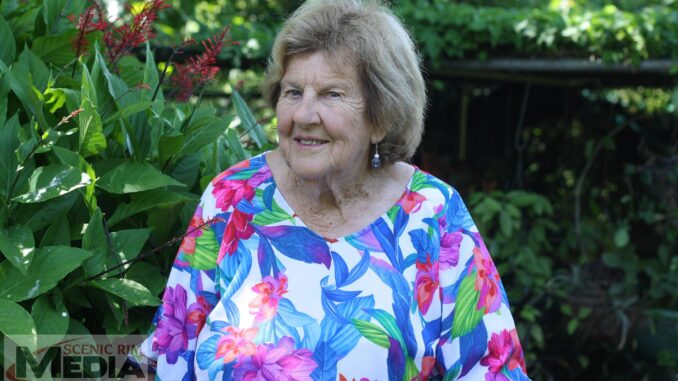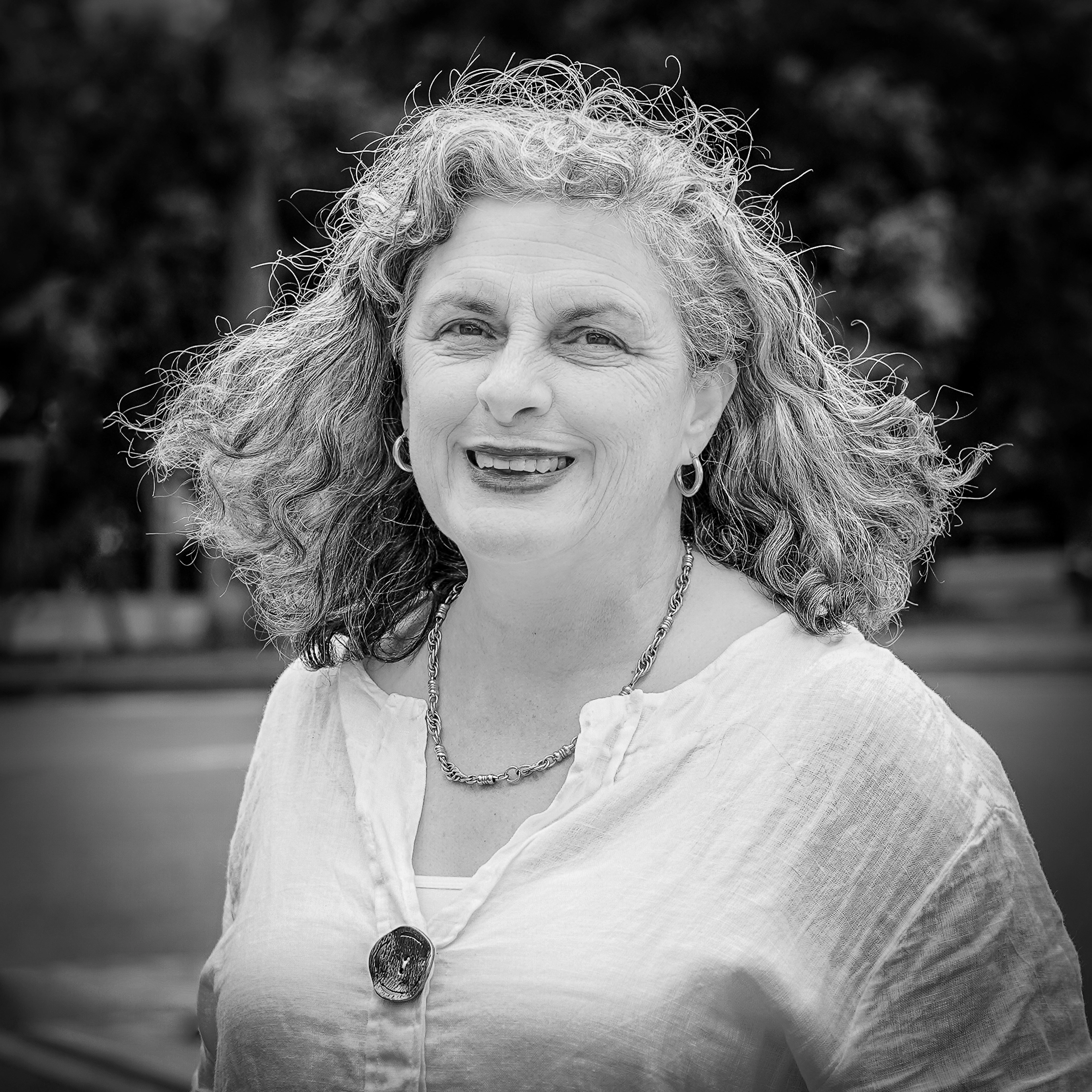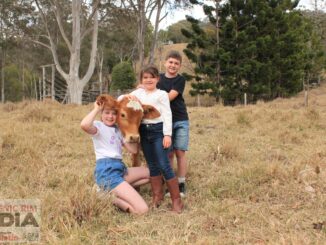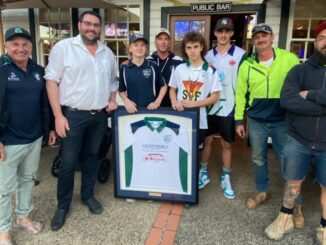
BORN and bred in Canungra, is a phrase that fits Cath Marsden more than most people in the area.
Family
Cath’s family connection to the town goes back several generations. She was born in Canungra Hospital, which once stood on the hill where Canungra Showground is now; and she still lives in the Christie family home, built by her great-great-grandfather Robert Christie, in 1873.
There is a lot of family history in that home. Robert lived there his whole life, with his wife and family and later his daughter (Cath’s great-grandmother) Catherine Duncan lived there until her death in 1924.

Photos of Catherine Duncan’s funeral 1924 (great grandmother), showing houses on Finch Road, people walking behind the cars behind the hearse. Catherine Duncan is buried in the Finch Road cemetery.
Cath says her father, John (Jack) Smith was born in the lougeroom of her home and in a fitting analogy of the circle of life, he is buried in the Smith – Duncan private cemetery across the road home the house.
Jack was the son of local businessman D J Smith, for whom the D J Smith Memorial Park in Canungra is named.

Cath at DJ Smith Park
Cath’s parents met when her mother came to the area to work at the hospital, an only child she had a happy upbringing. There were several houses in Finch Road back then and she attended the Finch Road school nearby.
She remembers a bus trip to Sydney as an adult, the driver was asking people where they came from and when he found out Cath was from Canungra he asked, “Did you know Benny Morris?”
It turned out they were neighbours when he lived in Canungra but it was so many years later they didn’t recognise each other!
School back then was a little different to what it is now. Local children walked and rode their horses to school and Cath has distinct memories of the effect of the second world war.
“When I first started at school we were only young and the war must have been on,” she recalls.
“When there was an air raid we would all go down into the gully and hide – teachers, all the children, everyone.”
“One of my friends, Deidre Murphy, used to ride her horse to school and tie him up while she was at school. But he was clever and used to raid all the lunchboxes!”
Behind the family home house there was a big swimming hole that was well known. Anyone could use it and many of the Finch Road students used to go swimming there.
Working life
After finishing school, Cath got a job as a typist at the jungle training centre, now Kokoda Barracks.
“I started there before the headquarters was finished. It was supposed to be finished October 1, 1956 but it wasn’t ready so we started working in a tent.”
Once the headquarters was completed in January 1957 they moved into the building and Cath spent the next 35 years working there.
In her time they progressed from old typewriters, to word processors and then to computers.
“It was hard to adjust but much easier once we got used to it. With the old manual typewriters there were some things we typed where you were not allowed make a mistake. You would be concentrating so hard and get nearly to the end and hit the wrong key … it was dreadful.”
Cath has fond memories of working there, particularly in the early days when the soldiers were going through to Malaya and Vietnam.
She enjoyed going to the marching out parades and the dances held at the centre.
“They used to have a bus from One Mill Hospital in Brisbane that brought nurses out to dance with the soldiers,” she said.
Several of the local girls ended up marrying soldiers, however before the married quarters were built, the soldiers’ wives were unable to live nearby. Once the married quarters were built, there were a few surprises.
“Before the married quarters came the soldiers were all supposed to be single, then when the married quarters were built a few local girls found out they’d been going out with married men!”
The army were also involved in district footaball matches with Canungra, Beaudesert and Boonah all taking part in the competition. The army bus would take army personnel and civilians to the matches.. They had an army bus that let anybody get on to go to the matches.
“I used to play the piano in those days and when we got back on the Sunday night I’d play at the canteen and they’d all have a sing-song,” said Cath.
Life with Des
This was where she met her husband, Des, who was a civilian manager at the canteen
It wasn’t love at first sight – Cath had another boyfriend at the time and thought of Des as a friend.
“We used to go to the canteen and sit in the beer garden for lunch. Des would always come and sit with us.”
When her boyfriend was transferred, he said to Cath, “Whatever you do, don’t go and marry Des.”
It took four years but it eventually happened. Des and Cath were married in 1965 and moved into the family home where Cath lives today.
She continued to work at the Jungle Training Centre and she and Des also enjoyed showing water fowl and taking care of their property and their pets.
All creatures great and small
Her love of animals is very clear as soon as you visit. Cath has a range of pets – birds, a donkey, miniature pony and a cat.
Even as a child she used to rear orphaned animals, some were given to her by O’Reilly’s or local people (before the days of Wildcare). One of these was a large male red kangaroo, affectionately known as Red. The local vet advised her to get it desexed, saying they could get quite aggressive as they got older, however this was not the case with Red.
“He was the quietest animal. He grew about as tall as me and he would put his arms around you – paws around your wait and his head on your shoulder. He was just gorgeous.”
She and Des had a pig named Arnold who Cath says was very intelligent. Arnold slept out the back on a rubber mattress with a pillow, lying lie full length with his head on the pillow.
He came when he as called and was a much loved pet.
Beaudesert Vet, John Ryan, desexed Arnold and become very fond of him. Whenever Cath saw John in Beaudesert he’d ask how Arnold was.
“When he finally got sick and had to be put down, I got John to come over,” recalls Cath.
“I was dreading it. I put my dark glasses on and went out to meet him. If he hadn’t said anything I wouldn’t have been so bad but he said ‘Oh Cath, oh poor old Arnold, oh I hate doing this’.”
“I had to walk away and said ‘Des, you handle it.’ He was a beautiful animal.
Cath has always had birds. Her favourite birds are geese but the foxes in the area made it impractical to keep them.
She and Des used to show waterfowl and enjoyed going to the shows at Boonah, Redland Bay, Beenleigh and beyond. At one time they had 12 show ducks and had cut a watertank in half for them to swim in.
They thought the duck enclosure was very secure but one night a fox got in by scaling the fence and escaped the same way.
“That was the end of our showing,” says Cath.
Health
Cath has battled breast cancer twice.
The first time she was in her fifties and had a lump removed, followed by six weeks of radiation.
“They said if it doesn’t come back in five years you’ll be clear, but 13 years later it came back.”
It was a tough time, having the cancer return after so long, but after a mastectomy and further treatment she has been clear ever since.
Sadly, in 2010, Des passed away from Pulmonary Fibrosis.
“They said he had about five years and it levelled out towards the end. But six weeks before he died they found he had cancer all through. He was devastated, it was such a shock.”
Des was buried in the Finch Road cemetery and Cath has kept a plot next to him for herself.
The cemetery, which contains 18 graves and four memorials, is very important to Cath. In 2018 it was put on the Local Heritage Register after she applied to have it listed.
After Des passed away she stayed on in the house, surrounded by her animals, not all of whom are welcome.
You need danger money
She has battled snakes on the property from time to time. One day she came home to find her cat lying inside the door – it had been swallowed and regurgitated by a snake.
“You could see where she’d been licked all over. Next thing this snake arrived on the top of my bird cage, a big carpet snake. I thought ‘how am I going to get it out?’. So I got the broom and got him out the door.”
After this incident she had any gaps around the house filled in and hasn’t had another snake in the house.
“You need danger money living her I tell you,” she laughs.
Today
Another of Cath’s great interests are the dolls she has been collecting since she was in her early twenties.
She has a huge range of antique dolls which she has collected over decades. They have come from around the world and many are displayed in glass cases in her home.
Ideally Cath would like to donate the dolls somewhere locally where they can be displayed.
Today she has slowed down a little but is still very active, caring for her eighteen year old donkey, Matty, her miniature pony and the birds she still cares for.
Cath, like her family, is truly one of Canungra’s treasures.

Cath Marsden with Matty the donkey






